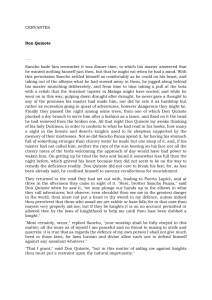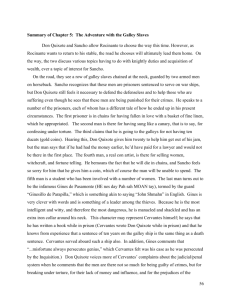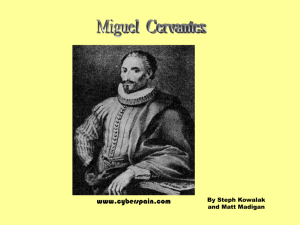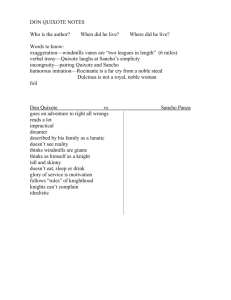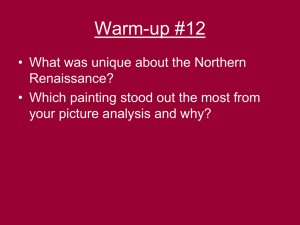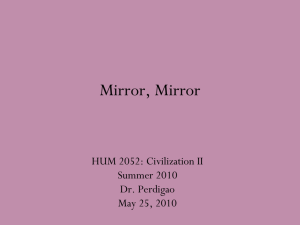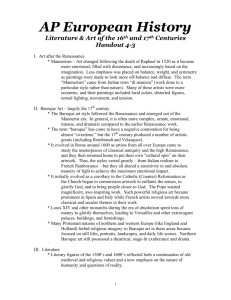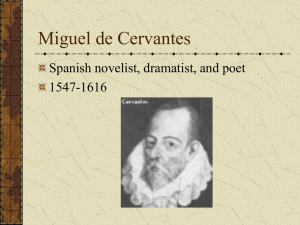Don Quixote Notes - Mrs. Beck
advertisement
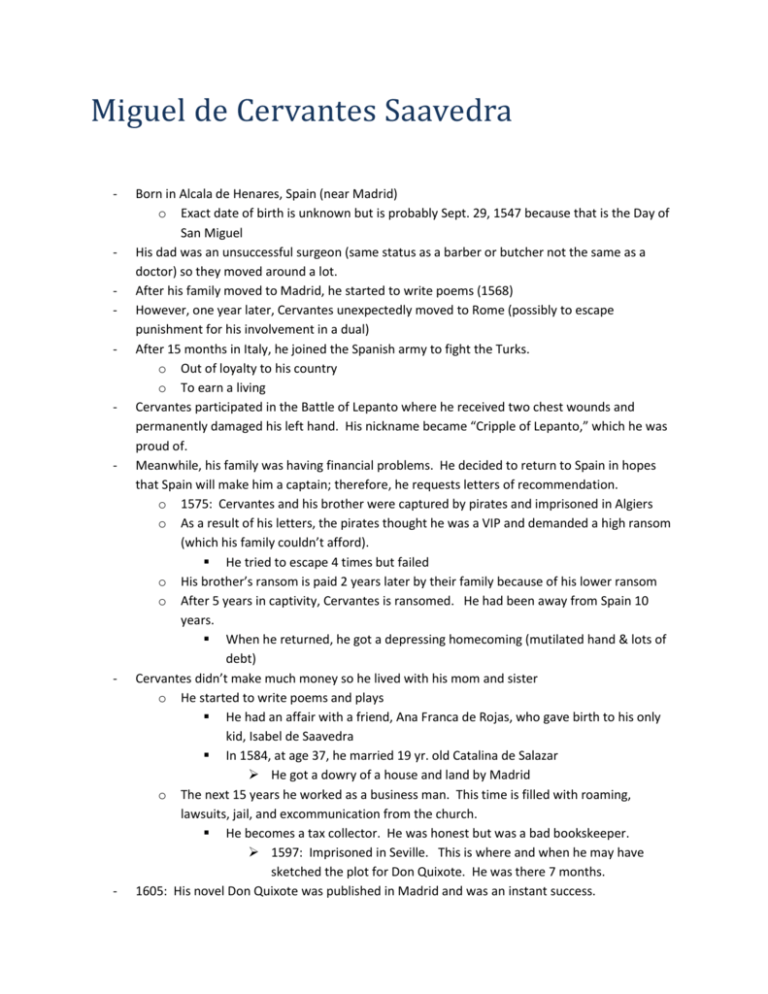
Miguel de Cervantes Saavedra - - - - - - Born in Alcala de Henares, Spain (near Madrid) o Exact date of birth is unknown but is probably Sept. 29, 1547 because that is the Day of San Miguel His dad was an unsuccessful surgeon (same status as a barber or butcher not the same as a doctor) so they moved around a lot. After his family moved to Madrid, he started to write poems (1568) However, one year later, Cervantes unexpectedly moved to Rome (possibly to escape punishment for his involvement in a dual) After 15 months in Italy, he joined the Spanish army to fight the Turks. o Out of loyalty to his country o To earn a living Cervantes participated in the Battle of Lepanto where he received two chest wounds and permanently damaged his left hand. His nickname became “Cripple of Lepanto,” which he was proud of. Meanwhile, his family was having financial problems. He decided to return to Spain in hopes that Spain will make him a captain; therefore, he requests letters of recommendation. o 1575: Cervantes and his brother were captured by pirates and imprisoned in Algiers o As a result of his letters, the pirates thought he was a VIP and demanded a high ransom (which his family couldn’t afford). He tried to escape 4 times but failed o His brother’s ransom is paid 2 years later by their family because of his lower ransom o After 5 years in captivity, Cervantes is ransomed. He had been away from Spain 10 years. When he returned, he got a depressing homecoming (mutilated hand & lots of debt) Cervantes didn’t make much money so he lived with his mom and sister o He started to write poems and plays He had an affair with a friend, Ana Franca de Rojas, who gave birth to his only kid, Isabel de Saavedra In 1584, at age 37, he married 19 yr. old Catalina de Salazar He got a dowry of a house and land by Madrid o The next 15 years he worked as a business man. This time is filled with roaming, lawsuits, jail, and excommunication from the church. He becomes a tax collector. He was honest but was a bad bookskeeper. 1597: Imprisoned in Seville. This is where and when he may have sketched the plot for Don Quixote. He was there 7 months. 1605: His novel Don Quixote was published in Madrid and was an instant success. o - - - Then someone was killed in front of their house and they were jailed for a brief time Shows his family was still held in low esteem 1614: A false Don Quixote part 2 appeared in print. It was by Alonso Fernández de Avellaneda. o Cervantes would have ignored it but the preface personally attacked him 1615: Cervantes’ Part 2 was published. But he was so exhausted, he fell ill. o He killed off Don Quixote so nobody else could write about him. 1616: On April 22, he dies. He dies sad about the fall out with his daughter. o Happened to be one week after William Shakespeare died. Literary Critics call him the “Father of the Modern Novel”. Before this novel, books were written as historical narravites, scientific works, plays, or epic poems. This was the first to contain a fictional narrative written in prose, not verse. Don Quixote has had wider distribution than any book except the Bible. El Ingenioso Hidalgo Don Quixote de la Mancha The Ingenious Gentleman Don Quixote of la Mancha by Miguel de Cervantes Saavedra Published in two parts (1605 & 1615) - - On the surface, it is seen as a humorous story of a madman’s adventures…so comedy and adventure story. It became a model for a new type of fiction with heroes who don’t conform to their times o Beneath the surface, it contains social satire (makes fun of society) and is a philosophic tale (discusses purpose of life). The first part was an immediate success! The only thing that was criticized were the little stories that were added in that didn’t have anything to do with the main plot. These little stories were; therefore, left out of part two. o The hero of Don Quixote is a Spanish landowner (Alonso Quixano) who enlivens his boring life by reading fictional tales about knights; however, he believes these stories to be true and accurate. He wishes to live like the knights so he takes the name Don Quixote de la Mancha, dresses in old armor, and sets out to gain fame by performing heroic deeds. He will distort all encounters so that they fit into a chivalric mold. o He swears allegiance to his “lady”, whom he calls Dulcinea del Toboso (dulce means sweet) but she is actually just a farm girl he met once named Aldonza Lorenzo. o He leaves on an old horse that he names Rocinante (Rocin means nag and antes means before so to most people this means it was once a horse but he translates it as above and beyond all other horses.) o He needs to be dubbed a knight. He comes upon an inn (castle) and has the owner make him a knight, which he does but muleteers also beat him up. o The innkeeper informed him that all great knights have squires so he heads home to get one. On the way home, he sees a boy getting beaten by his boss….Don Quixote interferes and the boy gets beat even worse. Then he meets some merchants (knights) and he challenges them to fight but they don’t want to and they end up stoning him. A neighbor finds him and takes him home. o When he gets home and tells about his adventures, his family and friends blame his books for his madness and burn them. o He stays home a few weeks but is planning on heading out again with a neighbor (who is usually a sensible man but Don Quixote has been filling his head with crazy ideas and - promises of islands and kingdoms to govern). His name is Sancho Panza (which means wide belly). o They come across some windmills (giants) and DQ ends up getting beat by the windmills who he said were transformed by his enemy the wizard Freston because Freston didn’t want DQ “to win”. o When they stay at an inn (castle), DQ doesn’t want to pay for the room so Sancho ends up getting tossed in a blanket. o They come across flocks of sheep who DQ says are armies so he challenges the sheppards to fight. The sheppards stone him. o They meet a barber with his basin on his head (helmet of Mambrino). DQ captures it and wears it proudly from then on. o They meet galley slaves who DQ believes are unjustly condemned and ends up freeing. He orders the slaves to report to Dulcinea on how brave he was but they insult Dulcinea and stone him. One slave, Gines de Pasamonte, ends up stealing Sancho’s donkey, which he eventually gets back. o DQ heads to the mountains of Sierra Morena and sends Sancho to Toboso with a letter for Dulcinea. Sancho bumps into the priest and the barber who were looking for DQ and they come up with a plan to get DQ back home. It involves dressing a stranger up like a princess named Micomicona who is supposedly searching for DQ’s help to seek revenge on a giant Pandafilando who has stolen her father’s throne in Africa…a reward would be given. DQ wants to help so they all go to an inn where DQ ends up killing the giant (stabbing bags of wine). o Don Quixote gets put in a wooden cage by the priest and the barber (who are disguised still) and is taken home. They tell him that he is under a spell. Part one observations: o Small round Sancho riding a donkey (Dapple) contrasts with the tall thin Don Quixote on his scrawny horse o Their conversations make up most of the story and this dialogue sets Cervantes’ writing apart from others of his time o Sancho symbolizes: reality, drama, being, and sanity His one downfall is the materialism that motivates him o Don Quixote symbolizes: fantasy, comedy, seeming, and madness Everything he does is devoted to knight errantry ****Meanwhile, Alonso Fernandez de Avellaneda wrote and finished a part two to the book in 1614. Cervantes would have ignored the counterfeit book but Avellaneda wrote a scathing preface to the book personally attacking Cervantes (old, prison, poor, friendless, etc….) - In 1615, Cervantes finished part two. o After a month of being at home, he is amazed to find out that a book has been written about them (Cervantes’ part 1). This makes him very happy and proud. o o o o o o o He sets off with Sancho again in search of Dulcinea. They see some farm girls and Sancho, tired of searching, tells DQ that one of them is Dulcinea. DQ professes his love even though he says it is obvious that an enchanter has turned his pretty Dulcinea into an ugly farm girl. Meet up with Knight of the Wood and his squire (actually neighbor Samson Carrasco…sent by DQ’s family to try to get him home… and another neighbor) who brags of beating DQ and making him say his lady was the best. DQ gets mad at this lie and they challenge each other to a dual for the next day. DQ wins and makes the Knight of the Mirrors (renamed because of all the mirrors on his armor) say that Dulcinea is the most beautiful. A lion in a cage, owned by the King, refuses to face DQ. DQ destroys all the puppets in a puppet show thinking they were real Moors and had to pay for the damages. They meet up with a Duke and Duchess who have read the book about DQ and decide to invite him and Sancho back to their palace and “play tricks” on them, including giving Sancho an “island” to govern and having them ride blindfolded on a wooden horse full of firecrackers. Finally, the Knight of the White Moon (Samson Carrasco again) challenges DQ to a dual. The conditions are that if DQ wins then the Knight of the White Moon will admit that Dulcinea is the most beautiful and DQ can add this win to his accomplishments but if DQ loses then he must admit that Dulcinea is not the most beautiful and go home for a year. DQ loses but refuses to say anything that insults Dulcinea because he would rather die. The Knight of the White Moon says it is okay if he just goes home. Don Quixote is so sad that he becomes ill and to the dismay of Sancho he confesses the folly of his past adventures just before he dies. So at the end, the two have reversed their roles: DQ renounces his life of chivalry and Sancho pleads with him to resume his knightly career.
